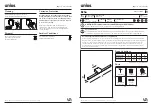
44
User's Guide HDSP System Multiface II
© RME
25. TotalMix: Routing and Monitoring
25.1 Overview
The Multiface includes a powerful digital real-time mixer, the
Hammerfall DSP mixer,
based on
RME’s unique, sample-rate independent
TotalMix
technology. It allows for practically unlimited
mixing and routing operations, with all inputs and playback channels simultaneously, to any
hardware outputs.
Here are some typical applications for TotalMix:
•
Setting up delay-free submixes (headphone mixes). The Multiface allows for up to 10 (!) fully
independent stereo submixes. On an analog mixing desk, this would equal 20 (!) Aux sends.
•
Unlimited routing of inputs and outputs (free utilisation, patchbay functionality).
•
Distributing signals to several outputs at a time. TotalMix offers state-of-the-art splitter and
distributor functions.
•
Simultaneous playback of different programs via a single stereo output. The ASIO multi-
client driver supports the usage of several programs at the same time. When done on differ-
ent playback channels TotalMix provides the means to mix and monitor these on a single
stereo output.
•
Mixing of the input signal to the playback signal (complete ASIO Direct Monitoring). RME not
only is
the
pioneer of ADM, but also offers the most complete implementation of the ADM
functions.
•
Integration of external devices. Use TotalMix to insert external effects devices, be it in the
playback or in the record path. Depending on the current application, the functionality equals
insert or effects send and effects return, for example as used during real-time monitoring
when adding some reverb to the vocals.
Every single input channel, playback channel and hardware output features a Peak and RMS
level meter, calculated in hardware (hardware output is Peak only). These level displays are
very useful to determine the presence and routing destinations of the audio signals.
For a better understanding of the TotalMix mixer you should know the following:
•
As shown in the block diagram (next page), the record signal usually stays un-altered. To-
talMix does not reside within the record path, and does not change the record level or the
audio data to be recorded (exception: loopback mode).
•
The hardware input signal can be passed on as often as desired, even with different levels.
This is a big difference to conventional mixing desks, where the channel fader always con-
trols the level for all routing destinations simultaneously.
•
The level meter of inputs and playback channels are connected pre-fader, to be able to visu-
ally monitor where a signal is currently present. The level meters of the hardware’s outputs
are connected post-fader, thus displaying the actual output level.
Summary of Contents for DSP Multiface
Page 5: ...User s Guide HDSP System Multiface II RME 5 User s Guide Multiface II General...
Page 42: ...42 User s Guide HDSP System Multiface II RME...
Page 43: ...User s Guide HDSP System Multiface II RME 43 User s Guide Multiface II TotalMix...
Page 45: ...User s Guide HDSP System Multiface II RME 45...
Page 67: ...User s Guide HDSP System Multiface II RME 67 User s Guide Multiface II Technical Reference...
Page 74: ...74 User s Guide HDSP System Multiface II RME 31 Diagrams 31 1 Block Diagram Multiface II...
Page 76: ...76 User s Guide HDSP System Multiface II RME...
Page 77: ...User s Guide HDSP System Multiface II RME 77 User s Guide Multiface II Miscellaneous...
















































